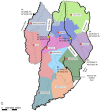In vitro susceptibility to fosfomycin in clinical and environmental extended-spectrum beta-lactamase producing and/or ciprofloxacin-non-susceptible Escherichia coli isolates
- PMID: 38324871
- PMCID: PMC10846478
- DOI: 10.1590/S1678-9946202466005
In vitro susceptibility to fosfomycin in clinical and environmental extended-spectrum beta-lactamase producing and/or ciprofloxacin-non-susceptible Escherichia coli isolates
Abstract
Extended-spectrum beta-lactamase producing and ciprofloxacin-non-susceptible Escherichia coli are clinical and environmental issues. We evaluated the susceptibility profile of fosfomycin in non-susceptible E. coli isolated from urine and the environment. We measured the activity of fosfomycin against 319 and 36 E. coli strains from urine and environmental isolates, respectively, collected from rivers. Fosfomycin resistance profiles were investigated using the minimal inhibitory concentration (MIC), according to the Clinical and Laboratory Standards Institute (CLSI) and the European Committee for Antimicrobial Susceptibility Testing (EUCAST) guidelines. Antibiotic susceptibility testing revealed that 5% and 6.6% of urine samples were non-susceptible to fosfomycin according to CLSI and EUCAST guidelines, respectively. The fosfomycin MIC50/90 was 0.5/4 mg/L. Of the 36 E. coli isolates from river water, 11.1% and 13,8% were non-susceptible to fosfomycin according to CLSI and EUCAST, respectively (range ≤0.25 ≥512 mg/L). All the isolates with MIC ≥512 mg/L for fosfomycin showed the fosA3 gene. Fosfomycin resistance was more frequent in the environment than in clinical samples.
Conflict of interest statement
CONFLICT OF INTERESTS
FFT is a CNPq researcher. The authors declare no conflict of interests.
Figures



Similar articles
-
[Fosfomycin susceptibility of urinary Escherichia coli isolates producing extended-spectrum beta-lactamase according to CLSI and EUCAST recommendations].Mikrobiyol Bul. 2014 Oct;48(4):545-55. Mikrobiyol Bul. 2014. PMID: 25492650 Turkish.
-
In vitro activity of fosfomycin against ciprofloxacin-resistant or extended-spectrum beta-lactamase-producing Escherichia coli isolated from urine and blood.Diagn Microbiol Infect Dis. 2007 May;58(1):111-5. doi: 10.1016/j.diagmicrobio.2006.11.015. Epub 2007 Feb 14. Diagn Microbiol Infect Dis. 2007. PMID: 17300900
-
Antimicrobial susceptibility and mechanisms of fosfomycin resistance in extended-spectrum β-lactamase-producing Escherichia coli strains from urinary tract infections in Wenzhou, China.Int J Antimicrob Agents. 2017 Jul;50(1):29-34. doi: 10.1016/j.ijantimicag.2017.02.010. Epub 2017 Apr 26. Int J Antimicrob Agents. 2017. PMID: 28456703
-
Antimicrobial susceptibilities of extended-spectrum beta-lactamase-producing Escherichia coli and Klebsiella pneumoniae in health care-associated urinary tract infection: focus on susceptibility to fosfomycin.Int Urol Nephrol. 2015 Jul;47(7):1059-66. doi: 10.1007/s11255-015-1018-9. Epub 2015 May 31. Int Urol Nephrol. 2015. PMID: 26026972
-
The Activity of Fosfomycin Against Extended-Spectrum Beta-Lactamase-Producing Isolates of Enterobacteriaceae Recovered from Urinary Tract Infections: A Single-Center Study Over a Period of 12 Years.Microb Drug Resist. 2018 Jun;24(5):607-612. doi: 10.1089/mdr.2017.0097. Epub 2017 Oct 24. Microb Drug Resist. 2018. PMID: 29064348
References
-
- Waller TA, Pantin SA, Yenior AL, Pujalte GG. Urinary tract infection antibiotic resistance in the United States. Prim Care. 2018;45:455–466. - PubMed
-
- Foxman B. The epidemiology of urinary tract infection. Nat Rev Urol. 2010;7:653–660. - PubMed
-
- Rocha JL, Tuon FF, Johnson JR. Sex, drugs, bugs, and age: rational selection of empirical therapy for outpatient urinary tract infection in an era of extensive antimicrobial resistance. Braz J Infect Dis. 2012;16:115–121. - PubMed
-
- Wagenlehner FM, Bjerklund Johansen TE, Cai T, Koves B, Kranz J, Pilatz A, et al. Epidemiology, definition and treatment of complicated urinary tract infections. Nat Rev Urol. 2020;17:586–600. - PubMed
MeSH terms
Substances
LinkOut - more resources
Full Text Sources
Medical

